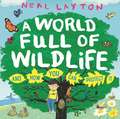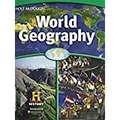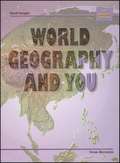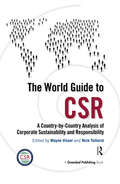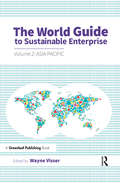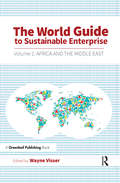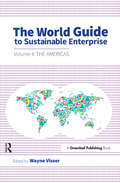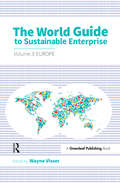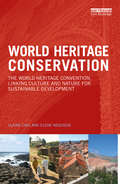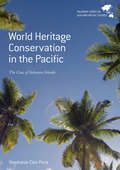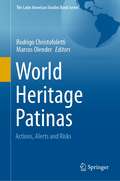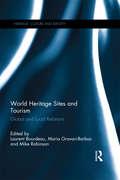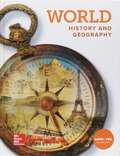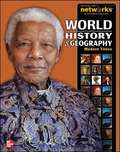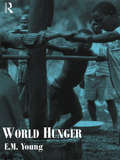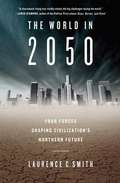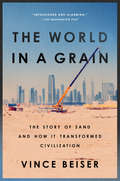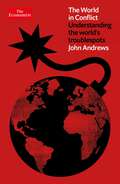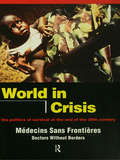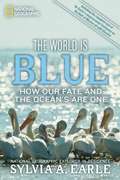- Table View
- List View
A World Full of Wildlife: and how you can protect it
by Neal LaytonEvery animal and plant on earth is part of an incredible WEB OF LIFE. But living things are disappearing all over the world, and it's a big problem. Award-winning author-illustrator Neal Layton is here to introduce the concept of biodiversity to younger readers, explaining what it is, why it's so important, and how the actions of humans are hurting it. But he's also FULL of ideas for how you can help! From building a bug hotel to growing flowers on a windowsill and eating more organic food, A World Full of Wildlife will get young readers excited about how they can make a difference to keep the web of life bursting with energy.This brilliant non-fiction picture book is perfect for readers aged 5-7 who love nature and want to help the environment.Also available in this series:A Planet Full of PlasticA Climate in Chaos
World Geography: Building a Global Perspective
by Thomas J. Baerwald Celeste FraserNIMAC-sourced textbook
World Geography
by Preston E. James Nelda DavisGo on a geographical tour around the world! Explore the world while solving the riddle using informational clues about each country. Students study 30 countries, grouped by continent, using maps, charts, graphs, puzzles, and hands-on activities.
World Geography
by Christopher L. SalterIn ESSENTIALS OF WORLD REGIONAL GEOGRAPHY, 4th Edition, Kit Salter and Joe Hobbs build the story of each region using contemporary concerns, global issues, and historical themes to create a complete picture of our ever-changing planet and its people. The authors help students understand what aspects of a place give it identity and personality by detailing what features make it newsworthy now and what features might make it critical in the 21st century. ESSENTIALS OF WORLD REGIONAL GEOGRAPHY, 4th Edition, is a market leading text with a unique chapter layout that allows for flexibility of topic coverage. "Profile Chapters" introduce a region in global terms by discussing the overall physiographic, economic, historical, economic, and cultural attributes that characterize a large world region (such as Europe or Monsoon Asia). Subsequent chapters then elaborate at a more local level (i. e. , subregions and countries) about the finer-scale details, e. g. what geographical factors have made Germany a very different place from France. The advantages of this approach are that the profile chapters allow an instructor a great amount of latitude in how to cover a region. In a one-semester course, for example, many professors might choose to focus on covering only the profile chapters for many of the regions. In that way, the book lends itself very well to semester- or even quarter-length courses. Coverage of global themes is given strong focus and is integrated within a traditional regional organization. Another key strength of the book is its pedagogical structure, accented by a number of boxed elements: "Definitions and Insights", "Regional Perspectives", "Problem Landscapes", "Landscape in Literature", and "Perspectives from the Field" (see description below). These boxed elements combine to identify common themes across regional boundaries, as well as to clarify terms of common usage that may nevertheless be less than familiar to today' s students.
World Geography and You: The Complete Edition
by Vivian BernsteinAs you study world geography, you will learn what the land looks like in different parts of the world. You will learn how people live in different places. You will study how people have changed the places where they live. You will also study the culture of people in different countries. Culture is the ideas, art, and way of life of a group of people. When you study about culture, you learn about food, clothing, sports, customs, and language of a group of people. Religion is also part of culture. Religion is the different ways people believe and pray to a god or to many gods.
World Geography Today
by Holt Rinehart WinstonHave you ever wondered...why some places are deserts while other places get so much rain? What makes certain times of the year cooler than others? Why do some rivers run dry? Maybe you live near mountains and wonder what processes created them. You will learn about this and so much more in this book.
The World Guide to CSR: A Country-by-Country Analysis of Corporate Sustainability and Responsibility
by Wayne Visser Nick TolhurstThe World Guide to CSR is the first book to provide comparable national profiles that describe the evolution and practice of Corporate Sustainability and Responsibility (CSR) for 58 countries and 5 global regions. Each regional and national profile includes key information about the relevant CSR history, country-specific issues, trends, research and leading organizations. The purpose of the book is to give CSR professionals (including managers, consultants, academics and NGOs focusing on the social, environmental and ethical responsibilities of business) a quick reference guide to CSR in different regional and national contexts. The need for the book is premised on the fact that CSR professionals and researchers more often than not have a multinational remit and are required to benchmark performance internationally, but find that country-specific CSR information is ad hoc, limited or non-existent. Even where national CSR research exists, it is often hidden in academic journals that practitioners cannot access or do not have the time or inclination to read. The book is an edited volume, with expert contributors from around the world, all of whom have been screened and selected on the basis of their qualifications and experience in CSR. Each regional/country profile includes the following subsections:CSR in context Priority issues Trends Legislation and codes Organizations Case studies Educational institutions References This unique resource will be an essential acquisition for all organisations who need to benchmark their CSR strategies throughout different regions and cultures and want the best possible intelligence on the key issues and concerns relating to corporate social responsibility in all of the markets in which they operate.
The World Guide to Sustainable Enterprise: Volume 2: Asia Pacific
by Wayne VisserThe World Guide to Sustainable Enterprise is the first comprehensive global compendium that clearly describes the national approaches to sustainable enterprise. Through a systematic review of each country, this quick-to-access reference guide showcases the similarities and differences in each region. Every country profile includes key information about the relevant history, country-specific issues, trends, research, and the leading organizations operating in the field as well as best-practice case studies. The guide comprises four volumes, each dedicated to a specific region of the world. In a world where organizations are working increasingly across national and regional boundaries and research takes a joined-up and international approach, this book is an essential guide for practitioners and researchers in the disciplines of business sustainability, social enterprise and corporate responsibility. The first of its kind, this reference book provides the reader with a unique insight into what is the current state-of-play in each country. Each edited volume provides expert contributions from around the world; the contributors have been selected on the basis of their knowledge of the country and their clear experience in sustainable enterprise. Each regional/country profile includes the following subsections: Sustainable Enterprise in context; Priority issues; Trends; Government policies; Case studies; Further resources; and References. This unique resource will be an essential acquisition for all organizations who need to benchmark their sustainable enterprise strategies throughout different regions and cultures and want the best possible intelligence on the key issues and concerns relating to sustainable business and social responsibility in all of the markets in which they operate. It provides a useful companion reference collection to the World Guide to CSR, also edited by Wayne Visser. The full Four Volume Set of The World Guide to Sustainable Enterprise is available for purchase as a single item at a 25% discounted rate.
The World Guide to Sustainable Enterprise: Volume 1: Africa and Middle East
by Wayne VisserThe World Guide to Sustainable Enterprise is the first comprehensive global compendium that clearly describes the national approaches to sustainable enterprise. Through a systematic review of each country, this quick-to-access reference guide showcases the similarities and differences in each region. Every country profile includes key information about the relevant history, country-specific issues, trends, research, and the leading organizations operating in the field as well as best-practice case studies. The guide comprises four volumes, each dedicated to a specific region of the world. In a world where organizations are working increasingly across national and regional boundaries and research takes a joined-up and international approach, this book is an essential guide for practitioners and researchers in the disciplines of business sustainability, social enterprise and corporate responsibility. The first of its kind, this reference book provides the reader with a unique insight into what is the current state-of-play in each country. Each edited volume provides expert contributions from around the world; the contributors have been selected on the basis of their knowledge of the country and their clear experience in sustainable enterprise. Each regional/country profile includes the following subsections: Sustainable Enterprise in context; Priority issues; Trends; Government policies; Case studies; Further resources; and References. This unique resource will be an essential acquisition for all organizations who need to benchmark their sustainable enterprise strategies throughout different regions and cultures and want the best possible intelligence on the key issues and concerns relating to sustainable business and social responsibility in all of the markets in which they operate. It provides a useful companion reference collection to The World Guide to CSR, also edited by Wayne Visser. The full Four Volume Set of The World Guide to Sustainable Enterprise is available for purchase as a single item at a 25% discounted rate.
The World Guide to Sustainable Enterprise: Volume 4: the Americas
by Wayne VisserThe World Guide to Sustainable Enterprise is the first comprehensive global compendium that clearly describes the national approaches to sustainable enterprise. Through a systematic review of each country, this quick-to-access reference guide showcases the similarities and differences in each region. Every country profile includes key information about the relevant history, country-specific issues, trends, research, and the leading organizations operating in the field as well as best-practice case studies. The guide comprises four volumes, each dedicated to a specific region of the world. In a world where organizations are working increasingly across national and regional boundaries and research takes a joined-up and international approach, this book is an essential guide for practitioners and researchers in the disciplines of business sustainability, social enterprise and corporate responsibility. The first of its kind, this reference book provides the reader with a unique insight into what is the current state-of-play in each country. Each edited volume provides expert contributions from around the world; the contributors have been selected on the basis of their knowledge of the country and their clear experience in sustainable enterprise. Each regional/country profile includes the following subsections: Sustainable Enterprise in context; Priority issues; Trends; Government policies; Case studies; Further resources; and References. This unique resource will be an essential acquisition for all organizations who need to benchmark their sustainable enterprise strategies throughout different regions and cultures and want the best possible intelligence on the key issues and concerns relating to sustainable business and social responsibility in all of the markets in which they operate. It provides a useful companion reference collection to the World Guide to CSR, also edited by Wayne Visser. The full Four Volume Set of The World Guide to Sustainable Enterprise is available for purchase as a single item at a 25% discounted rate.
The World Guide to Sustainable Enterprise - Volume 3: Europe
by Wayne VisserThe World Guide to Sustainable Enterprise is the first comprehensive global compendium that clearly describes the national approaches to sustainable enterprise. Through a systematic review of each country, this quick-to-access reference guide showcases the similarities and differences in each region. Every country profile includes key information about the relevant history, country-specific issues, trends, research, and the leading organizations operating in the field as well as best-practice case studies. The guide comprises four volumes, each dedicated to a specific region of the world. In a world where organizations are working increasingly across national and regional boundaries and research takes a joined-up and international approach, this book is an essential guide for practitioners and researchers in the disciplines of business sustainability, social enterprise and corporate responsibility. The first of its kind, this reference book provides the reader with a unique insight into what is the current state-of-play in each country. Each edited volume provides expert contributions from around the world; the contributors have been selected on the basis of their knowledge of the country and their clear experience in sustainable enterprise. Each regional/country profile includes the following subsections: Sustainable Enterprise in context; Priority issues; Trends; Government policies; Case studies; Further resources; and References. This unique resource will be an essential acquisition for all organizations who need to benchmark their sustainable enterprise strategies throughout different regions and cultures and want the best possible intelligence on the key issues and concerns relating to sustainable business and social responsibility in all of the markets in which they operate. It provides a useful companion reference collection to the World Guide to CSR, also edited by Wayne Visser. The full Four Volume Set of The World Guide to Sustainable Enterprise is available for purchase as a single item at a 25% discounted rate.
World Heritage Benefits Beyond Borders
by Amareswar GallaPublished on the 40th anniversary of the World Heritage Convention, this thematic collection of case studies provides a thorough understanding of World Heritage sites and their Outstanding Universal Value in the context of sustainable development. The case studies describe twenty six thematically, typologically and regionally diverse World Heritage sites illustrating their benefits to local communities and ecosystems and sharing the lessons learned with the diverse range of stakeholders involved. The volume emphasises a holistic and integrated view of World Heritage, linking it to the role local communities play in management and protection, and to issues of ecosystem sustainability, and the maintenance of biological, linguistic and cultural diversity. Cross-disciplinary in its scope, this book will provide a meeting point for researchers, practitioners, community representatives and the wider public and will promote cultural and natural heritage conservation as a key vector of sustainable development and social cohesion.
World Heritage Conservation: The World Heritage Convention, Linking Culture and Nature for Sustainable Development
by Claire Cave Elene NegussieThe UNESCO World Heritage Convention has become one of the most successful UN instruments for promoting cultural diplomacy and dialogue on conservation of cultural and natural heritage. This book provides an overview of the convention through an interdisciplinary approach to conservation. It shows that based on the notion of outstanding universal value and international cooperation for the protection of heritage, the convention provides a platform for sustainable development through the conservation and management of heritage of significance to humanity. With increasing globalization of heritage, World Heritage Conservation is reviewed as an emerging interdisciplinary field of study creating new opportunities for inclusive heritage debate both locally and globally, requiring common tools and understanding. With over a thousand properties inscribed on the World Heritage List, from biologically diverse sites such as the Central Amazon Conservation Complex to the urban landscape of the metropolis of Rio de Janeiro, the book will help students, researchers and professionals in the identification, protection, conservation and presentation of World Heritage. Targeted at a diversity of disciplines, the book critically describes the strategies for implementing the convention and the processes of heritage governance for sustainable development.
World Heritage Conservation in the Pacific: The Case of Solomon Islands (Palgrave Series in Asia and Pacific Studies)
by Stephanie Clair PriceThis book explores the opportunities and challenges associated with the legal protection of World Heritage sites in the Pacific Islands. It argues that the small Pacific representation on the World Heritage List is in part due to a lack of strong legal frameworks for heritage conservation, putting such sites under threat. Providing a comprehensive analysis of the nomination, listing and protection of the Solomon Island World Heritage Site, it examines the implementation of the World Heritage Convention in the Pacific context. It explores how the international community’s broadening interpretation of the notion of ‘outstanding universal value’ has increased the potential for Pacific heritage to be classified as ‘World Heritage’. This book also analyses the protection regime established by the Convention, and the World Heritage Committee’s approach to heritage conservation, identifying challenges associated with the protection of Pacific Island heritage.
World Heritage Patinas: Actions, Alerts and Risks (The Latin American Studies Book Series)
by Rodrigo Christofoletti Marcos OlenderThis book presents studies on the management of the Brazilian world heritage and its international counterparts, relating its preservationist practices to the risks and alerts that run its maintenance in the face of so many challenges in the contemporary world. The book has encouraged scholars from a wide variety of disciplines to contribute their valuable knowledge to research on the management and risks of Brazil's world heritage. It is a bold initiative that brings together contemporary studies on management, alerts and risks of the Brazilian world heritage and some international examples. It stands out not only for its interdisciplinary approach, but above all for compiling a wide range of approaches that analyze various dimensions of world heritage management. Unique experience in the management of world heritage allocated to Brazilian territory, this book was written by prominent academics and heritage management professionals and includes national and international case studies. It is a comprehensive academic book in Brazilian world heritage management literature and can therefore be used as an authoritative reference source as well as a significant teaching tool.
World Heritage Sites and Tourism: Global and Local Relations (Heritage, Culture and Identity)
by Laurent Bourdeau Maria Gravari-Barbas Mike RobinsonNot all World Heritage Sites have people living within or close by their boundaries, but many do. The designation of World Heritage status brings a new dimension to the functioning of local communities and particularly through tourism. Too many tourists accentuated by the World Heritage label, or in some cases not enough tourists, despite anticipation of increased numbers, can act to disrupt and disturb relations within a community and between communities. Either way, tourism can be seen as a form of activity that can generate interest and concern as it is played out within World Heritage Sites. But the relationships that World Heritage Sites and their consequent tourism share with communities are not just a function of the number of tourists. The relationships are complex and ever changing as the communities themselves change and are built upon long-standing and wider contextual factors that stretch beyond tourism. This volume, drawing upon a wide range of international cases relating to some 33 World Heritage Sites, reveals the multiple dimensions of the relations that exist between the sites and local communities. The designation of the sites can create, obscure and heighten the power relations between different parts of a community, between different communities and between the tourism and the heritage sector. Increasingly, the management of World Heritage is not only about the management of buildings and landscapes but about managing the communities that live and work in or near them.
World History & Geography: Modern Times
by Jackson J. Spielvogel Jay MctigheBuilt on the principles of Understanding by Design, the streamlined student text includes core world history standards in a concise, accessible format.
World Hunger
by Liz YoungWorld Hunger explores the nature and extent of contemporary world hunger, explaining why hunger still persists while agricultural production increases and genetic engineering revolutionises food production and distribution. Numerous case studies, drawn from the North and South, illustrate the diversity of diets in the world and the connections between the global and local. Globalisation and access to food in the global supermarket is examined.Explaining the essential political character of hunger, the author exposes popular myths and identifies positive changes where prevailing inequalities and ideologies are challenged and it becomes possible to envisage a world where hunger is history.
The World in 2050
by Smith LaurenceThe New North explores the four forces that are changing the world - climate change, rising population, globalisation and resource depletion - and attempts to predict how they will shape the world between now and 2050. It is a book about people, and the "push" and "pull" factors that determine where and how they live. In particular, it examines the countries of the far north - Scandinavia, Canada, Greenland, etc - which stand to gain from the changes underway. The book is not a doomsday script. All of human history is a story of adaptation and change, in response to our environment and to each other. Despite our booming numbers we are healthier, safer, better fed, more knowledgeable, and less violent than ever before. The population boom is slowing, our prosperity generally rising. And as our coastlines inundate and the deserts encroach, there will be new homelands for us throughout the high latitudes and high altitudes, places currently marginal for human existence. Who will benefit? Who will suffer? Current migration trends - to Florida and the drought-stricken American southwest, towards vulnerable low-lying coasts, into Asian megacities atop subsiding deltas - will go into reverse. Instead, we will turn north, where the tragic loss of unique ecosystems will be countered by rising biological production, stable water supplies, warmer winters, rising food stocks, and new shipping access throughout the region. These physical benefits intertwine crucially with human ones, like abundant cheap land, stable governance and legal systems, new oil discoveries, the end of indigenous land-claims, and rising global markets for energy, raw materials, and food.
The World in a Grain: The Story of Sand and How It Transformed Civilization
by Vince BeiserThe gripping story of the most important overlooked commodity in the world--sand--and the crucial role it plays in our lives.After water and air, sand is the natural resource that we consume more than any other--even more than oil. Every concrete building and paved road on Earth, every computer screen and silicon chip, is made from sand. From Egypt's pyramids to the Hubble telescope, from the world's tallest skyscraper to the sidewalk below it, from Chartres' stained-glass windows to your iPhone, sand shelters us, empowers us, engages us, and inspires us. It's the ingredient that makes possible our cities, our science, our lives--and our future.And, incredibly, we're running out of it.The World in a Grain is the compelling true story of the hugely important and diminishing natural resource that grows more essential every day, and of the people who mine it, sell it, build with it--and sometimes, even kill for it. It's also a provocative examination of the serious human and environmental costs incurred by our dependence on sand, which has received little public attention. Not all sand is created equal: Some of the easiest sand to get to is the least useful. Award-winning journalist Vince Beiser delves deep into this world, taking readers on a journey across the globe, from the United States to remote corners of India, China, and Dubai to explain why sand is so crucial to modern life. Along the way, readers encounter world-changing innovators, island-building entrepreneurs, desert fighters, and murderous sand pirates. The result is an entertaining and eye-opening work, one that is both unexpected and involving, rippling with fascinating detail and filled with surprising characters.
The World in Conflict: Understanding the World's Troublespots (Economist Books)
by John AndrewsAn authoritative, incisive explanation of the causes and current status of hostilities around the world.The world today rests on increasingly unstable fault lines. From the conflict in Ukraine or fresh upheavals in the Middle East to the threats posed to humanity by a global pandemic, climate change, and natural disasters, the world's danger zones once again draw their battle lines across our hyper-connected, yet fragmented, globe. In this revised and updated fourth edition, join veteran Economist journalist John Andrews as he analyzes the old enmities and looming collisions that underlie conflict in the twenty-first century. Region by region, discover the causes, contexts, participants, and likely outcomes of every globally significant struggle now underway. From drug cartels to cyber war, this is the indispensable guide for anyone who wants to understand our perilous world.
World in Crisis: Populations in Danger at the End of the 20th Century
by Médicins Sans Frontières/Doctors Without BordersThe tragedies of war, famine, disease and poverty continue to dominate our headlines. Faced with such tragedy, the politics, ethics, even the economics of humanitarian aid are becoming more complex. The role of relief agencies, the political will of the West, the reponsibilities of the international community for war crimes and human rights - these are all issues at the heart of contemporary humanitarian aid.World in Crisis - describing the plight of refugees and civilians caught up in war zones in both First and Third Worlds, the homeless, Gypsies, and AIDS/HIV groups in Europe and North America - highlights what can be done to alleviate human suffering in the future. The book concludes with reports from the frontline of the world's main conflict zones, in Bosnia, Liberia/Sierra Leone, Chechnya, Rwanda/Burundi and Sudan.Medecins Sans Frontieres/Doctors Without Borders is the world's largest independent organization for emergency medical aid. Through 25 years of action, the organization has become famous for bringing swift and direct aid to peoples affected by war and natural disaster, regardless of government consent.
The World Is Blue: How Our Fate and the Ocean's Are One
by Sylvia A. EarleExplorer-in-residence at the National Geographic Society, oceanographer Earle adds blue to the green movement by explaining the importance of the earth's ocean to the health of its life. She begins by setting out the conventional vision of the ocean's limitless bounty for harvesting wildlife and infinite resiliency as the ultimate garbage disposal. Then she explains how the ocean is suffering from biodiversity loss, drilling, mining, shipping, spilling, and changing climate and chemistry. The final section surveys opportunities for reversing the tide by exploring and governing the ocean, smart aquaculture, and protective measures. Annotation c2009 Book News, Inc., Portland, OR (booknews.com)
The World Is Ours to Cherish: A Letter to a Child
by Mary Annaïse HeglarThis hopeful picture book--written in the style of a letter--gives kids an honest take on climate change and urges them to band together to help the planet.The world is a big, beautiful place full of natural wonders--everything from bees to rainfall can seem magical.The world is also changing. Climate change has already had a devastating effect on the planet.But it's not too late! If we work together and show a little more care, both for the environment and each other, we can keep this world beautiful.This moving debut from climate writer Mary Annaïse Heglar is perfect for budding environmentalists and anyone in need of a little hope for the future of our planet.
